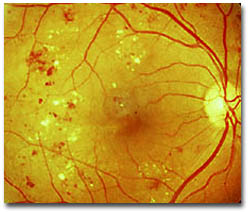| Essential topics/experience:
To have become familiar with the following: i. Diabetic retinopathy: classification, screening strategies, management. ii. Hypertensive and arteriosclerotic
retinopathy: including macroaneurysms and branch
iii. Retinal vascular occlusions: recognition of ischaemic and exudative responses; rubeosis. iv. Macular diseases: including recognition of age-related maculopathy, subretinal neovascularisation, cystoid macular odema, macular hole; related symptomatology and urgency of treatment. v. Fluorescein angiography: indications, complications and interpretation. vi. Liaison: with diabetologists, vascular surgeons, low vision services. Practical skills:
i. Assessment of macular function (Amsler Chart, Watske Allen slit beam test). ii. Scatter laser photocoagulation of the peripheral retina [20]. Background theory/principles:
i. Fundus imaging including scanning laser ophthalmoscopy. ii. Indocyanine green angiography. iii. Electrodiagnostic tests and dark adaptation. iv. Genetic retinal disease: retinal dystrophies, retinoblastoma. v. Differential diagnosis and treatment of malignant melanoma. vi. Macular laser photocoagulation: principles and laser safety. vii. Toxic maculopathy and central serous retinopathy. viii. Intraocular lymphoma. ix. Intermediate and posterior uveitis: toxoplasmosis, toxocara and sympathetic ophthalmia; retinal vasculitis. x. Coats’ disease, other telangiectasis and the retinal phakomatoses. xi. AIDS-related opportunistic infections and anti-AIDS treatment. xii. Low vision aids, including optical principles and fitting. |
|||
|
